November, 2021. Note: This post has it all: factual analysis of an anthropology mystery; pithy social commentary; great photographs; and at the end of the post, a bilingual short-story by the most famous writer in Mexico: Carlos Fuentes. There is something for everyone here.
Notice: This is shameless plug for future business. I enjoyed writing this post so much, I am going to start a new regular feature: the Aztec God of the Month Club. If you want to get a monthly thrill ‘n’ chill the ole Aztec way, please subscribe to this website. The free subscription service is available by pushing the “subscribe” link on the upper right section of the home page. For me, the Ancient Egyptian mythology is in a league without peer. Yet, in Aztec mythology, there is something unmatched with their blood-curdling, nightmare-inducing world of death, destruction, despair and human sacrifice . I just find it charming.
The Five W’s of Chac Mool — Who, What, Where, etc.
Chac Mool is alive for some of us. But in reality, Chac Mool is a specific type of unique statue found only in Meso-America (Mexico and Guatemala). Chac Mool is associated with the Aztecs and Mayans from 800 to 1250 C.E. The statue depicts a reclined man holding a tray or bowl either on his stomach or chest. Throughout recent centuries, this statue was well known to scholars and grave robbers alike. Yet everyone just put aside the worthless, unnamed puzzle piece (now known as Chac Mool) and keep on digging — there had to be gold in here somewhere! (or whatever was the prize). Chac Mool got his name from the French archeologist Augustus LePlongeon. In 1875, LePlongeon unearthed yet another of those pesky statues in Chichén Itzá, Yucatán; this one from the 9th century. LePlongeon mistakenly identified Chac Mool as a depiction of the ancient Maya ruler “Thunderous Paw,” or Chaacmol. Although Chac Mool has no relation to Thunderous Paw; the name stuck. So far, fourteen of these statues were found at Chichén Itzá.
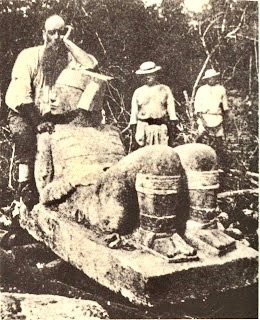
Chac Mool is an enigma: everything about him is mystery; from his real name, to his story in Aztec lore; to his symbolic significance. Neither anthropologist nor shaman nor modern-day Aztec Priest (tlamacazqui) can explain Chac Mool’s origin, significance or purpose. The only clue is a tantalizing link between Chac Mool and Tlaloc, the Mesoamerican god of rain and thunder. Chac Mool often reclines on a rectangular base. These small plinths usually contain fine stone inscriptions and pictographs related to water generally, the ocean specifically; and/or the rain god Tlaloc. Carvings of Tlaloc can often be found on the bottom of the statues. Nobody knows why.
Yet, Mexico and Guatemala are lousy with this still unknown Chac Mool [“lousy”meaning these statues are all over the place]. Statues of Chac Mool are strewn throughout Aztec and Mayan Meso-America. Not surprising given his geographic and cultural range; Chac Mool comes in many flavors. He can be anything from an old-man, nearly naked; to a young stud warrior kitted out for battle. Chac Mool tends to human size, but miniature and gigantor models exist. Below is just a sliver of the many, many examples of Chac Mool found throughout this region; although oddly enough, certain geographic areas of these ancient empires are lacking in Chac Mool statues, without rhyme or reason. Take a look and pick your favorite Chac Mool:
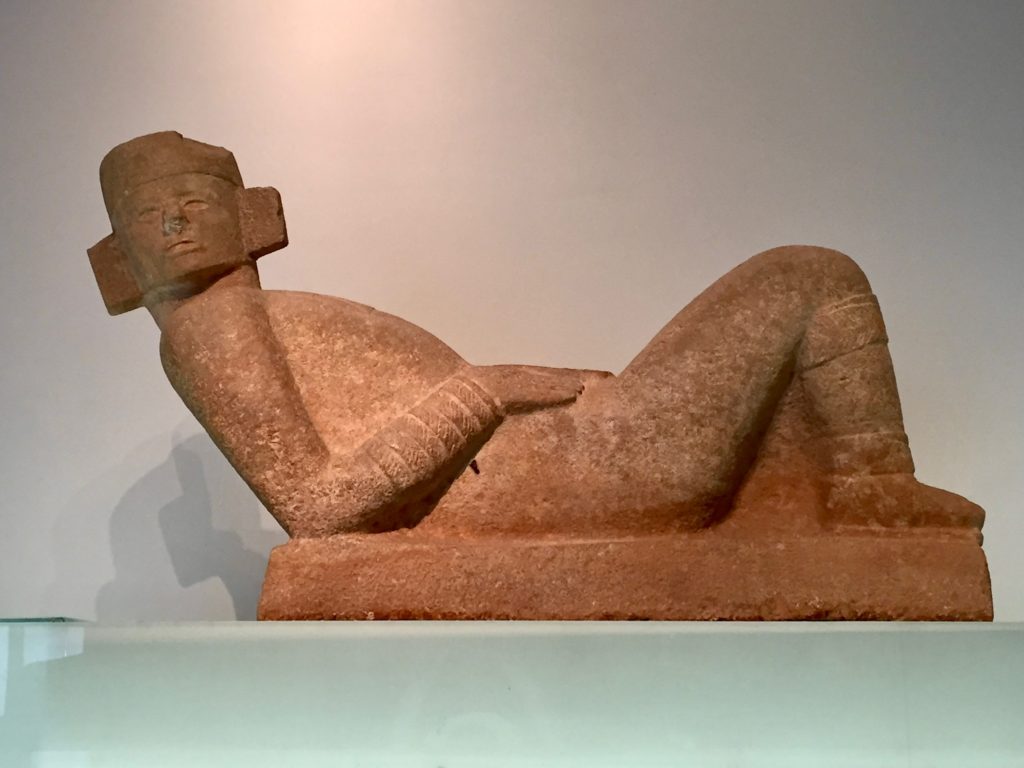
Classic depiction from Museo de Anthropolgia, Mexico City 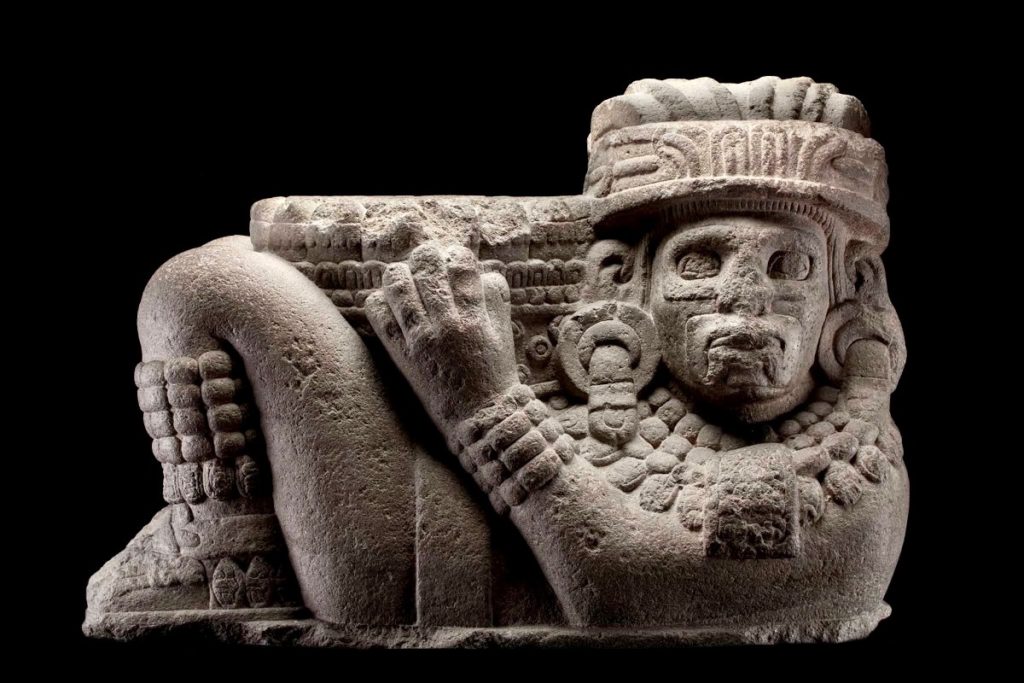
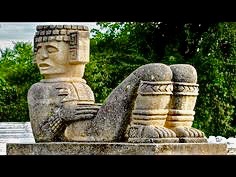
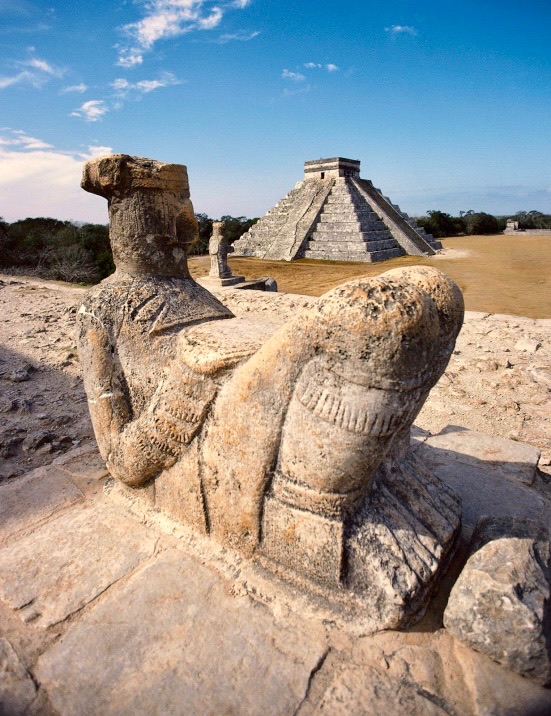
Chac Mool at Chichén Itzá 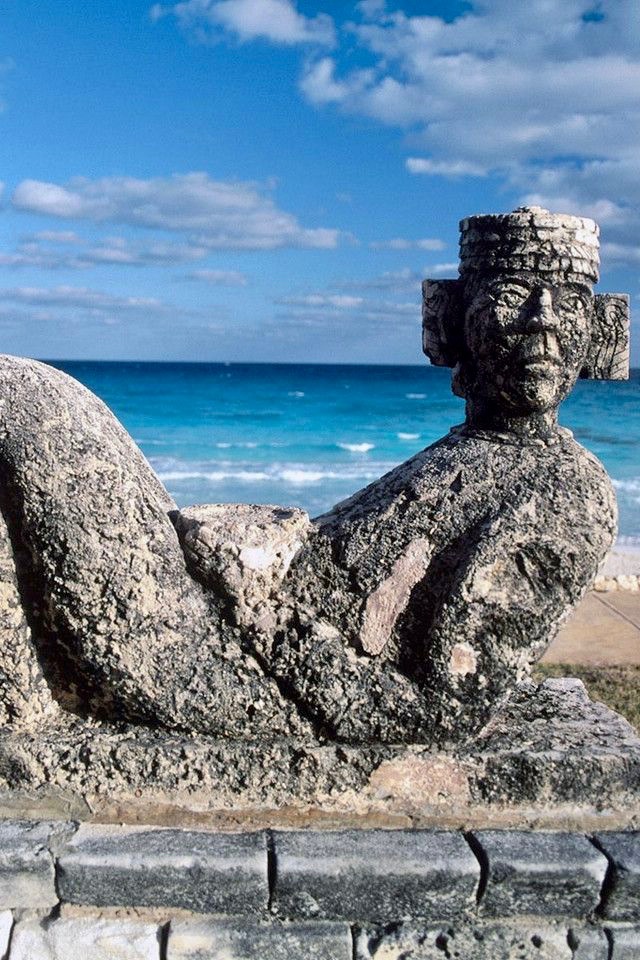
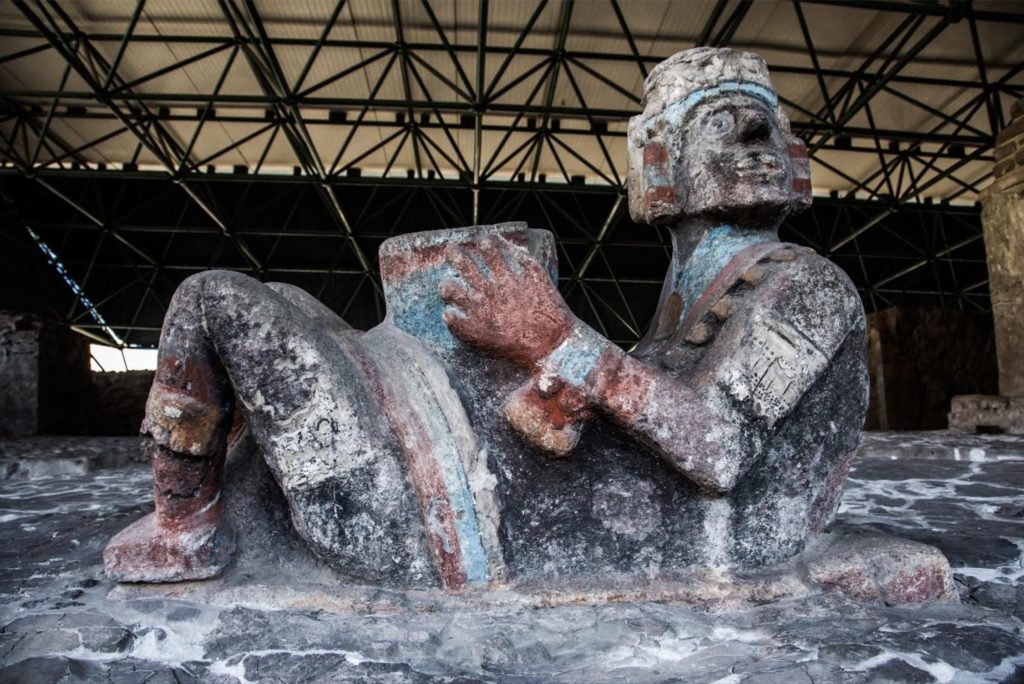
I study and ponder Chac Mool periodically and have done so for years. I have fallen into desuetude over time by the lacuna of information to decipher the enigma: there is no answer to this burning, anthropological conundrum.[Sorry. Ignore this last sentence. One year for Christmas, my sister gave me a set called The Complete English Vocabulary, and effective communication been downhill ever since] Back to this burning question:
Who the hell is this guy? Why doesn’t he get up and start his day?
Well, it is not like Chac Mool has to work so he can keep on living. In fact, Chac Mool is immortal. He achieved the ultimate reincarnation. Chac Mool has come back as money:
Chac Mool — The Story. By Carlos Fuentes
Side Note: Perhaps readers think I personify this statue too much; I treat Chac Mool as if he was a living person. Wait until you see what Carlos Fuentes does to this limestone statue on a plinth. Enjoy in two languages.
“Chac Mool” by Carlos Fuentes — Bilingual Edition English/Spanish. This short story was the bugaboo of intermediate Spanish students at my Spanish language school in Cuzco, Peru. Cuzco is the picturesque town very reminiscent of Santa Fe, N.M.; but Cuzco also serves as the jumping off point for Machu Picchu. I was one class behind in the course sequence; thus, I was not required to read this story. Students from all over the world flew to Cuzco, Peru to show their eager-beaverness by pissing and moaning (USA slang) during break time about being forced to read a wretched short story in Spanish. Finally, a student spat out the name of the accursed author: Carlos Fuentes. I went into rapture when I heard that curse. Fuentes is the most famous Mexican writer of the middle 20th century. For his time, Fuentes’ writings had scandalous sexual innuendos, and scathing social critique. The Catholic Church condemned and banned his work. Government officials publically reviled his odious writings. Meanwhile, Carlos Fuentes was beloved by literary critics, and loved by his large reading audience. His most famous work is “The Death of Artemio Cruz.” Naturally, I fished out of the garbage bin a hard copy of this story that some future Rhodes Scholar had hurled into the can, all the while insulting Fuentes’ mother. Lucky me: this story is a plum. As the English say: very jammy! The story, first published in 1954, is presented below first in English; then in Spanish.
“Chac Mool” by Carlos Fuentes – Translated by Jonah Katz
Not too long ago, Filbert died by drowning in Acapulco. It happened during All Saints’ week. Although he’d been dismissed from his job in the Ministry, Filbert couldn’t resist the bureaucratic temptation to go, same as every year, to the German pensión, to eat sauerkraut sweetened by the sweat of the tropical kitchen, to dance on the Saturday of glory in La Quebrada, and to feel himself a “regular” in the dark anonymity of evening on the beach of Hornos. Clearly, we know that in his youth he had swum well, but now, at forty, and in as bad shape as he seemed to be; to try to cover, and at midnight, such a distance! Frau Müller wouldn’t permit his vigil –such an old client– to be held in the pensión. On the contrary, that night she organized a dance on the little suffocated terrace, while Filbert waited, very pallid in his box, for the morning truck to depart the terminal, and passed the first night of his new life accompanied by baskets and bundles. When I arrived, early, to watch over the shipment of the coffin, Filbert was under a mountain of coconuts; the driver said we should arrange him quickly on the awning and cover him with tarps, so that the passengers wouldn’t get frightened, and to make sure we wouldn’t bring a curse on the voyage.
We left Acapulco, still in the breeze. Toward Tierra Colorada the heat and light came to life. Over a breakfast of eggs and sausage, I opened Filbert’s briefcase, retrieved the day before, along with his other belongings, from the Müllers’ pensión. Two hundred pesos. An old newspaper; lottery stubs; a one-way ticket –only one way?–, and the cheap notebook, with pages divided into squares and covers of marble paper.
I ventured to read it, in spite of the curves, the stench of vomit, and a certain natural sentiment of respect for the private life of my deceased friend. It would record – yes, I started with that– our everyday work in the office; maybe I would find out why he’d been in decline, neglecting his duties, why he was dictating official documents without feeling, or number, or “effective suffrage.”* Why, in the end, he had run away, forsaking a pension, with no regard for the payrolls.
“Today I went to fix up all that business about my pension. The lawyer was very friendly. I left there so happy that I decided to spend five pesos in a café. It’s the same one we went to when we were young and that nowadays I never enter, because it reminds me that I could afford more luxuries at twenty than I can at forty. In those days, we’d all been on the same plane, we would have rejected with energy any negative opinions about our comrades; in fact we waged war on those in the house who even mentioned bad breeding or lack of elegance. I knew that many (perhaps the most humble) would go very far, and here, in school, they would forge the lasting friendships in whose company we would cross the wild seas. No, it wasn’t like that. There were no rules. Many of the humble ones stayed there, many went further than we could have predicted at those lively, friendly gatherings. Others, we who seemed to have all the promise, we remained
- “Effective suffrage, not reelection!” was the slogan with which Francisco Madero and the Mexican revolutionaries opposed the reelection of General Porfirio Diaz. The allusion is ironic, now that the revolutionary slogan has been transformed, according to the text, into a phrase devoid of meaning, which is ritually appended to official documents.
in the middle of the road, disembowelled in an extracurricular test, isolated by an invisible trench from those who triumphed and from those who never accomplished anything. Finally, today I came back to sit in the seats, modernized –also, like the barricade of an invasion, a soda-fountain— and pretended to read briefs. I saw many of them, changed, amnesiac, retouched by neon light, prosperous. With the café that I almost didn’t recognize, with the city itself, they had been chiselling themselves out to a rhythm different than mine. No, they no longer recognized me, or didn’t want to. At the most –one or two— a fat, quick hand on the shoulder. Bye, old man, take it easy. Between them and me intervened the eighteen holes of the Country Club. I hid myself in the briefs. There paraded past me all the years of big dreams, of happy predictions, and also, all the omissions that impeded their realization. I felt the anguish of not being able to put my fingers in the past and fit together the pieces of some abandoned puzzle; but the toy chest is being forgotten, and in the long run, who knows where they’ve come to rest, all the tin soldiers, the helmets, the wooden swords. Such cherished disguises, they were nothing more than that. And, nonetheless, there had been constancy, discipline, devotion to duty. Had that not been enough, or did it suffice? I was struck, on occasion, by the memory of Rilke. The great payback for the adventure of youth must be death; young people, we should do away with all our secrets. Today, I wouldn’t have to return my gaze to the cities of salt. Five pesos? Two for the tip.”
“Pepe, apart from his passion for commercial law, enjoys theorizing. He saw me leave the cathedral and together we walked to the Palace. He’s a non-believer, but that’s not enough for him: in half a block he had to fabricate a theory. That if I weren’t a Mexican, I wouldn’t worship Christ, and –no, look, it seems evident. Here come the Spanish and they propose that you worship a God, killed by a coagulation, with a wounded flank, nailed on a cross. Sacrificed. An offering. What could be more natural than accepting a sentiment so close to your whole ceremonial, to your whole life…? Imagine, instead, that Mexico had been conquered by Buddhists or Mohammedans. It’s not conceivable that our Indians would venerate an individual who died of indigestion. But a God who, it’s not enough that they sacrifice themselves for him, but also that they tear his heart out; caramba! Check-mate to Huitzilopochtli!* Christianity, in its warm, bloody feeling, of sacrifice and liturgy, turns into a natural and novel prolongation of the indigenous religion. The aspects of charity, love, and the other cheek, in turn, are rejected. And everything in Mexico is that: you have to kill men to be able to believe in them.
“Pepe knew my affinity, since my youth, for certain forms of indigenous Mexican art. I collect statuettes, idols, pottery. My weekends are spent in Tlaxcala, in Teotihuacán. Perhaps for this reason, he likes to relate all the theories he elaborates for my consumption back to these themes. It’s certain that I’ve been looking for a reasonable replica of Chac Mool** for some time, and today Pepe tells me about a place in La Lagunilla where they’re selling one of stone, and cheap, it seems. I’m going to go on Sunday.
“Some joker dyed the cooler-water in the office red, with the consequent disruption of work. I’ve had to bring it to the attention of the director, who just laughed a
- God of war, the main god in the Aztec pantheon.
** Mayan god of rain, especially important in the arid Yucatan region.
lot. The guilty party took advantage of this circumstance to make sarcastic comments to me all day, all having to do with water. Ch…!”
“Today, Sunday, I took the opportunity to go to la Lagunilla. I found the Chac Mool in the junk shop to which Pepe directed me. It’s a precious piece, of natural dimension, and although the merchant insists on its originality, I doubt it. The stone is common, but that doesn’t lesson the elegance of the posture or the solidity of the block. The disloyal vendor has smeared tomato sauce on its belly to convince tourists of the sculpture’s bloody authenticity.
“The move to my house cost me more than the acquisition. But it’s here now, for the moment in the basement while I reorganize my trophy room to make space for it. These figures need sun, vertical and fiery; that was their element and condition. He loses a lot in the darkness of the basement, like a simple mass of agony, and his grimace seems to reproach me for denying him light. The shop-owner had a light bulb directly above the sculpture, which clipped all the sharp edges, and gave a more friendly expression to my Chac Mool. I’ll have to follow his example.”
“I woke up this morning and the plumbing was broken. Carelessly, I left the water running in the kitchen and it overflowed, ran across the floor and went into the basement, without my noticing. The Chac Mool resists the humidity, but my suitcases suffered; and all this, on a work day, made me late to the office.
“They came, at last, to fix the pipes. The suitcases, twisted. And the Chac Mool, with moss on the base.”
“I woke up at one in the morning: I had heard a terrible moan. I thought maybe thieves. Pure imagination.”
“The nocturnal laments have continued. I don’t know what to attribute it to, but I’m nervous. Just to make matters worse, the plumbing is broken once again, and the rains have dripped inside, inundating the basement.”
“The plumber isn’t coming, I’m desperate. As for the Department of the Federal District, it’s better not to talk about it. This is the first time that the rainwater refuses to obey the drain-pipes and has drained into the basement. The moans have stopped; if it’s not one thing, it’s another.”
“They dried the basement out, and the Chac mool is covered in moss. It lends him a grotesque aspect, because the whole mass of the sculpture looks like it’s suffering from a green rash, save the eyes, which have remained of stone. I’ll set aside Sunday to scrape the moss. Pepe recommended that I switch to an apartment, and one on the top floor, in order to avoid these aquatic tragedies. But I can’t leave this big old house, certainly too big for me alone, a bit mournful in its Porfirian architecture, but it’s the only inheritance and memory of my parents. I don’t think I could stand to see a soda-fountain with a jukebox in the basement and a house of decorations on the ground floor.”
“I went to scrape the moss off of the Chac Mool with a spatula. The moss seemed to have become part of the stone already; the work took more than an hour, and only at six in the afternoon could I finish. It wasn’t possible to see in the half-light, and upon finishing the job, with my hand I followed the contours of the stone. Every time I scraped the block it seemed to grow softer. I didn’t want to believe it: it was almost a paste. That shopkeeper from la Lagunilla has taken me for a ride. His pre-Columbian sculpture is pure plaster, and the humidity will end up ruining it. I’ve put some rags over it, and tomorrow I’ll transfer it to the room upstairs, before it suffers a complete deterioration.”
“The rags are on the floor. Incredible. Once again I touched the Chac Mool. It’s hardened, but not turned back to stone. I don’t even want to write it: there is, in the torso, something of the texture of flesh, I squeeze it like rubber, feel that something is running through that reclining figure… I went back down in the night. No doubt remains: the Chac Mool has hair on his arms.”
“This had never happened to me before. Messing offficial matters up in the office: I issued a purchase order that hadn’t been authorized, and the director had to call it to my attention. I almost let myself be rude to my co-workers. I’ll have to go see a doctor, to find out if it’s imagination, or delirium, or what, and rid myself of that damned Chac Mool.”
Up to here, the handwriting of Filbert was the old version, the one that so many times I saw on memoranda and forms, wide and oval-shaped. The entry from August 25th seemed to be written by another person. At some times like a child, laboriously separating each letter; at others, nervous, to the point of declining into unintelligibility. There are three missing days, and the story continues:
“Everything is so natural; and later, what’s real is believed in…, but real it is, more than what’s believed in by me. A water-cooler is real, and more, because we take more notice of its existence, or presence, if a prankster dyes the water red… Real drag from an ephemeral cigarette, real monstrous image in a funhouse mirror, real, aren’t they, all of the dead, present and forgotten…? If a man walked around Heaven in a dream, and they gave him a flower as proof that he’d been there, and if upon waking up he found that flower in his hand…, then what…? Reality: one day they broke it in a thousand pieces , the head came to rest over there, the tail here, and we don’t know about more than one of the severed parts of its great body. Free and fictitious ocean, only real when it imprisons a snail. Up until three days ago, my reality only was one to the degree of having been erased today: it was a reflex movement, routine, memory, briefcase. And later, like the earth that one day trembles so that we remember its power, or death that will arrive, reprimanding the forgetfulness of all my life, another reality presents itself that we knew was there, homeless, that must shake us to make itself alive and present. I thought, anew, that it was imagination: the Chac Mool, smooth and elegant, had changed color in a night; yellow, almost gold, he seemed to indicate to me that he was a God, lax for the moment, with the knees less tensed than before, with the smile more benevolent. And yesterday, at last, a startled awakening, with that frightening certainty that there are two breaths in the night, that in the darkness there beat more pulses than one’s own. Yes, steps are heard on the staircase. Nightmare. Go back to sleep… I don’t know how long I
pretended to sleep. When I opened my eyes again, dawn still hadn’t come. The room smelled of horror, of incense and blood. With a black gaze, I scanned the bedroom, coming to rest on two orifices of blinking light, on two flickers, cruel and yellow.
Almost breathless I turned on the light.
There was Chac Mool, upright, smiling, ocher, with his belly flesh-colored. Two eyes paralyzed me, almost cross-eyed, very close to the triangular nose. The bottom teeth, biting the upper lip, unmoving; only the luster of the square headpiece on the abnormally voluminous head suggested life. Chac Mool advanced toward the bed; then it started to rain.”
I remember that at the end of August, Filbert was dismissed from the Ministry, with a public reprimand from the director, and rumors of madness and even theft. This I didn’t believe. Yes, I’d seen some pretty whacked-out memos, asking the Senior Official if water could be smelled, offering his services to the Secratary of Hydraulic Resources to make it rain in the desert. I didn’t know how to explain it to myself; I thought that the exceptionally strong rains, from that summer, had enervated him. Or that some moral depression must have been produced by life in that big, ancient house, with half the rooms under lock and key and covered in dust, without servants or family life. The following notes are from the end of September:
“Chac Mool can be nice when he wants to…, a glug-glug of delightful water… He knows fantastic stories about monsoons, equatorial rains, the punishment of the deserts; every plant derives from his mythic paternity: the willow, his long-lost son; the lotuses, his spoiled ones; his mother-in-law: the cactus. What I can’t stand is the smell, inhuman, that emanates from that flesh that isn’t flesh, from the ragged flaming shoes of antiquity. With a strident laugh, the Chac Mool reveals how he was discovered by Le Plongeon, and put, physically, in contact with men of other symbols. His spirit has lived in pitcher and storm, naturally; his stone is something else, and to have taken it from its hiding place is artificial and cruel. I think that Chac Mool will never forgive it. He knows about the imminence of the aesthetic deed.
“I’ve had to get him scouring soap so he can wash his stomach, which the merchant put ketchup on, thinking he was Aztec. He didn’t seem to like my question about his relation to Tláloc,* and, when he gets mad, his teeth, in and of themselves repulsive, grow sharp and glint. The first few days, he went down to sleep in the basement; since yesterday, in my bed.”
“The dry season has begun. Yesterday, from the hall where I sleep now, I started to hear the same hoarse wails from the beginning, followed by terrible noises. I went up and cracked open the door of the bedroom: the Chac Mool was breaking the lamps, the furniture; he lunged toward the door with his hands spread, and I barely had time to close it and go hide in the bathroom… Later, he came down panting and asked for water; all day he has the faucets running, there isn’t a dry centimeter left in the house. I have to sleep all bundled up, and I’ve asked him not to drench the hall any more.1”
- Aztec god of rain.
1 Filbert doesn’t explain in what language he converses with the Chac Mool [author’s note].
“The Chac Mool inundated the hall today. Exasperated, I said that I was going to bring him back to La Lagunilla. As terrible as his laugh –horrendously distinct from any laugh of man or animal—was the smack he gave me, with that arm loaded with heavy bracelets. I must admit it: I’m his prisoner. My original idea was different: I would dominate the Chac Mool, like one dominates a toy; it was perhaps, a prolongation of my infantile security; but childhood –who said it?— is a fruit eaten by the years, and I hadn’t realized… He’s taken my clothes, and he puts on the nightgowns when he starts to shed green moss. The Chac Mool is accustomed to being obeyed, always; I, who have never needed to command, can only submit. As long as it doesn’t rain –and his magical power?— he will live angrily or irritably.”
“Today I discovered that at night the Chac Mool leaves the house. Always, at dusk, he sings a song, out of tune and ancient, older than singing itself. Later, it stops. I knocked several times at his door, and when he didn’t answer me, I dared to enter. The bedroom, which I hadn’t seen again since the day the statue tried to attack me, is in ruins, and that smell of incense and blood that has permeated the house is concentrated there. But, behind the door, there are bones: dog bones, rats and cats. This is what the Chac Mool steals in the night to sustain himself. This explains all the frightening barking at dawn.”
“February, dry. Chac Mool watches every step of mine; he’s made me telephone a restaurant so that they’ll bring me daily rice with chicken. But the severance pay from the office is going to run out soon. The inevitable happened: since the 1st, they cut the water and the light for lack of payment. But Chac has discovered a public fountain two blocks from here; every day I make ten or twelve trips for water, and he watches me from the roof. He says if I try to flee he’ll strike me down; he’s also the god of lightning. What he doesn’t know is that I’m on to his nocturnal movements… Seeing as there’s no light, I must go to bed at eight. I already should be accustomed to the Chac Mool, but a little while ago, in the darkness, I ran into him on the stairs, I felt his icy arms, the scales of his renewed skin, and I wanted to scream.
“If it doesn’t rain soon, the Chac Mool is going to change into stone again. I’ve noticed his difficulty recently in moving,; sometimes he reclines for hours, paralyzed, and seems to be, once again, an idol. But these rests only give him new strength to torment me, to scratch me as if he could draw some kind of liquid from my flesh. Those friendly intervals in which he would relate old stories no longer take place; I think I notice a concentrated resentment. There have been other indications that have made me think: he’s almost finished off my wine cellar; he caresses the silk of the nightgowns; he wants me to bring a maid into the house; he’s made me teach him to use soap and lotions. I think that the Chac Mool is falling into human temptations; there’s even something old in the face that before seemed eternal. There may lie my salvation: if the Chac Mool is being humanized, maybe all his centuries of life will accumulate in an instant and he’ll be struck down. But also, here, could lie my own death: the Chac Mool won’t want me to be there for his downfall, it’s possible that he’ll want to kill me.
“Today I’ll take advantage of Chac’s nocturnal excursion in order to flee. I’ll go to Acapulco; we’ll see what can be done about acquiring a job, and await the death of the Chac Mool: yes, it’s settled; he’s gray, swollen. I need to sun myself, swim, recover my
strength. I have four hundred pesos left. I’ll go to the Pensión Müller, which is cheap and comfortable. Let Chac Mool keep everything: we’ll see how long he lasts without my buckets of water.”
Here ends the diary of Filbert. I didn’t want to think about his tale; I slept until Cuernavaca. From there to México I tried to give coherence to the screed, relate it to an excess of work, to some psychological motive. When at nine in the morning we arrived in the terminal, I couldn’t even conceive of the madness of my friend. I hired a truck to carry the coffin to Fibert’s house and from there to arrange his burial.
Before I could fit the key in the lock, the door was opened. A yellow Indian appeared, in a house robe, with a scarf. His appearance couldn’t have been more repulsive; he gave forth an odor of cheap lotion; his face, powdered, trying to cover the wrinkles; he had his lips smeared with badly-applied lipstick, and his hair gave the impression of being dyed.
“Pardon…, did you know that Filbert had…”
“It doesn’t matter; I know everything. Tell the men to bring the cadaver to the basement.”
| Chac Mool — Carlos Fuentes |
Hace poco tiempo, Filiberto murió ahogado en Acapulco. Sucedió en Semana Santa. Aunque había sido despedido de su empleo en la Secretaría, Filiberto no pudo resistir la tentación burocrática de ir, como todos los años, a la pensión alemana, comer elchoucrout endulzado por los sudores de la cocina tropical, bailar el Sábado de Gloria en La Quebrada y sentirse “gente conocida” en el oscuro anonimato vespertino de la Playa de Hornos. Claro, sabíamos que en su juventud había nadado bien; pero ahora, a los cuarenta, y tan desmejorado como se le veía, ¡intentar salvar, a la medianoche, el largo trecho entre Caleta y la isla de la Roqueta! Frau Müller no permitió que se le velara, a pesar de ser un cliente tan antiguo, en la pensión; por el contrario, esa noche organizó un baile en la terracita sofocada, mientras Filiberto esperaba, muy pálido dentro de su caja, a que saliera el camión matutino de la terminal, y pasó acompañado de huacales y fardos la primera noche de su nueva vida. Cuando llegué, muy temprano, a vigilar el embarque del féretro, Filiberto estaba bajo un túmulo de cocos: el chofer dijo que lo acomodáramos rápidamente en el toldo y lo cubriéramos con lonas, para que no se espantaran los pasajeros, y a ver si no le habíamos echado la sal al viaje.Salimos de Acapulco a la hora de la brisa tempranera. Hasta Tierra Colorada nacieron el calor y la luz. Mientras desayunaba huevos y chorizo abrí el cartapacio de Filiberto, recogido el día anterior, junto con sus otras pertenencias, en la pensión de los Müller. Doscientos pesos. Un periódico derogado de la ciudad de México. Cachos de lotería. El pasaje de ida -¿sólo de ida? Y el cuaderno barato, de hojas cuadriculadas y tapas de papel mármol.Me aventuré a leerlo, a pesar de las curvas, el hedor a vómitos y cierto sentimiento natural de respeto por la vida privada de mi difunto amigo. Recordaría -sí, empezaba con eso- nuestra cotidiana labor en la oficina; quizá sabría, al fin, por qué fue declinado, olvidando sus deberes, por qué dictaba oficios sin sentido, ni número, ni “Sufragio Efectivo No Reelección”. Por qué, en fin, fue corrido, olvidaba la pensión, sin respetar los escalafones.“Hoy fui a arreglar lo de mi pensión. El Licenciado, amabilísimo. Salí tan contento que decidí gastar cinco pesos en un café. Es el mismo al que íbamos de jóvenes y al que ahora nunca concurro, porque me recuerda que a los veinte años podía darme más lujos que a los cuarenta. Entonces todos estábamos en un mismo plano, hubiéramos rechazado con energía cualquier opinión peyorativa hacia los compañeros; de hecho, librábamos la batalla por aquellos a quienes en la casa discutían por su baja extracción o falta de elegancia. Yo sabía que muchos de ellos (quizá los más humildes) llegarían muy alto y aquí, en la Escuela, se iban a forjar las amistades duraderas en cuya compañía cursaríamos el mar bravío. No, no fue así. No hubo reglas. Muchos de los humildes se quedaron allí, muchos llegaron más arriba de lo que pudimos pronosticar en aquellas fogosas, amables tertulias. Otros, que parecíamos prometerlo todo, nos quedamos a la mitad del camino, destripados en un examen extracurricular, aislados por una zanja invisible de los que triunfaron y de los que nada alcanzaron. En fin, hoy volví a sentarme en las sillas modernizadas -también hay, como barricada de una invasión, una fuente de sodas- y pretendí leer expedientes. Vi a muchos antiguos compañeros, cambiados, amnésicos, retocados de luz neón, prósperos. Con el café que casi no reconocía, con la ciudad misma, habían ido cincelándose a ritmo distinto del mío. No, ya no me reconocían; o no me querían reconocer. A lo sumo -uno o dos- una mano gorda y rápida sobre el hombro. Adiós viejo, qué tal. Entre ellos y yo mediaban los dieciocho agujeros del Country Club. Me disfracé detrás de los expedientes. Desfilaron en mi memoria los años de las grandes ilusiones, de los pronósticos felices y, también todas las omisiones que impidieron su realización. Sentí la angustia de no poder meter los dedos en el pasado y pegar los trozos de algún rompecabezas abandonado; pero el arcón de los juguetes se va olvidando y, al cabo, ¿quién sabrá dónde fueron a dar los soldados de plomo, los cascos, las espadas de madera? Los disfraces tan queridos, no fueron más que eso. Y sin embargo, había habido constancia, disciplina, apego al deber. ¿No era suficiente, o sobraba? En ocasiones me asaltaba el recuerdo de Rilke. La gran recompensa de la aventura de juventud debe ser la muerte; jóvenes, debemos partir con todos nuestros secretos. Hoy, no tendría que volver la mirada a las ciudades de sal. ¿Cinco pesos? Dos de propina.”“Pepe, aparte de su pasión por el derecho mercantil, gusta de teorizar. Me vio salir de Catedral, y juntos nos encaminamos a Palacio. Él es descreído, pero no le basta; en media cuadra tuvo que fabricar una teoría. Que si yo no fuera mexicano, no adoraría a Cristo y -No, mira, parece evidente. Llegan los españoles y te proponen adorar a un Dios muerto hecho un coágulo, con el costado herido, clavado en una cruz. Sacrificado. Ofrendado. ¿Qué cosa más natural que aceptar un sentimiento tan cercano a todo tu ceremonial, a toda tu vida?… figúrate, en cambio, que México hubiera sido conquistado por budistas o por mahometanos. No es concebible que nuestros indios veneraran a un individuo que murió de indigestión. Pero un Dios al que no le basta que se sacrifiquen por él, sino que incluso va a que le arranquen el corazón, ¡caramba, jaque mate a Huitzilopochtli! El cristianismo, en su sentido cálido, sangriento, de sacrificio y liturgia, se vuelve una prolongación natural y novedosa de la religión indígena. Los aspectos caridad, amor y la otra mejilla, en cambio, son rechazados. Y todo en México es eso: hay que matar a los hombres para poder creer en ellos.“Pepe conocía mi afición, desde joven, por ciertas formas de arte indígena mexicana. Yo colecciono estatuillas, ídolos, cacharros. Mis fines de semana los paso en Tlaxcala o en Teotihuacán. Acaso por esto le guste relacionar todas las teorías que elabora para mi consumo con estos temas. Por cierto que busco una réplica razonable del Chac Mool desde hace tiempo, y hoy Pepe me informa de un lugar en la Lagunilla donde venden uno de piedra y parece que barato. Voy a ir el domingo.“Un guasón pintó de rojo el agua del garrafón en la oficina, con la consiguiente perturbación de las labores. He debido consignarlo al Director, a quien sólo le dio mucha risa. El culpable se ha valido de esta circunstancia para hacer sarcasmos a mis costillas el día entero, todos en torno al agua. Ch…”“Hoy domingo, aproveché para ir a la Lagunilla. Encontré el Chac Mool en la tienducha que me señaló Pepe. Es una pieza preciosa, de tamaño natural, y aunque el marchante asegura su originalidad, lo dudo. La piedra es corriente, pero ello no aminora la elegancia de la postura o lo macizo del bloque. El desleal vendedor le ha embarrado salsa de tomate en la barriga al ídolo para convencer a los turistas de la sangrienta autenticidad de la escultura.“El traslado a la casa me costó más que la adquisición. Pero ya está aquí, por el momento en el sótano mientras reorganizo mi cuarto de trofeos a fin de darle cabida. Estas figuras necesitan sol vertical y fogoso; ese fue su elemento y condición. Pierde mucho mi Chac Mool en la oscuridad del sótano; allí, es un simple bulto agónico, y su mueca parece reprocharme que le niegue la luz. El comerciante tenía un foco que iluminaba verticalmente en la escultura, recortando todas sus aristas y dándole una expresión más amable. Habrá que seguir su ejemplo.”“Amanecí con la tubería descompuesta. Incauto, dejé correr el agua de la cocina y se desbordó, corrió por el piso y llego hasta el sótano, sin que me percatara. El Chac Mool resiste la humedad, pero mis maletas sufrieron. Todo esto, en día de labores, me obligó a llegar tarde a la oficina.”“Vinieron, por fin, a arreglar la tubería. Las maletas, torcidas. Y el Chac Mool, con lama en la base.”“Desperté a la una: había escuchado un quejido terrible. Pensé en ladrones. Pura imaginación.”“Los lamentos nocturnos han seguido. No sé a qué atribuirlo, pero estoy nervioso. Para colmo de males, la tubería volvió a descomponerse, y las lluvias se han colado, inundando el sótano.”“El plomero no viene; estoy desesperado. Del Departamento del Distrito Federal, más vale no hablar. Es la primera vez que el agua de las lluvias no obedece a las coladeras y viene a dar a mi sótano. Los quejidos han cesado: vaya una cosa por otra.”“Secaron el sótano, y el Chac Mool está cubierto de lama. Le da un aspecto grotesco, porque toda la masa de la escultura parece padecer de una erisipela verde, salvo los ojos, que han permanecido de piedra. Voy a aprovechar el domingo para raspar el musgo. Pepe me ha recomendado cambiarme a una casa de apartamentos, y tomar el piso más alto, para evitar estas tragedias acuáticas. Pero yo no puedo dejar este caserón, ciertamente es muy grande para mí solo, un poco lúgubre en su arquitectura porfiriana. Pero es la única herencia y recuerdo de mis padres. No sé qué me daría ver una fuente de sodas con sinfonola en el sótano y una tienda de decoración en la planta baja.”“Fui a raspar el musgo del Chac Mool con una espátula. Parecía ser ya parte de la piedra; fue labor de más de una hora, y sólo a las seis de la tarde pude terminar. No se distinguía muy bien la penumbra; al finalizar el trabajo, seguí con la mano los contornos de la piedra. Cada vez que lo repasaba, el bloque parecía reblandecerse. No quise creerlo: era ya casi una pasta. Este mercader de la Lagunilla me ha timado. Su escultura precolombina es puro yeso, y la humedad acabará por arruinarla. Le he echado encima unos trapos; mañana la pasaré a la pieza de arriba, antes de que sufra un deterioro total.”“Los trapos han caído al suelo, increíble. Volví a palpar el Chac Mool. Se ha endurecido pero no vuelve a la consistencia de la piedra. No quiero escribirlo: hay en el torso algo de la textura de la carne, al apretar los brazos los siento de goma, siento que algo circula por esa figura recostada… Volví a bajar en la noche. No cabe duda: el Chac Mool tiene vello en los brazos.”“Esto nunca me había sucedido. Tergiversé los asuntos en la oficina, giré una orden de pago que no estaba autorizada, y el Director tuvo que llamarme la atención. Quizá me mostré hasta descortés con los compañeros. Tendré que ver a un médico, saber si es mi imaginación o delirio o qué, y deshacerme de ese maldito Chac Mool.”Hasta aquí la escritura de Filiberto era la antigua, la que tantas veces vi en formas y memoranda, ancha y ovalada. La entrada del 25 de agosto, sin embargo, parecía escrita por otra persona. A veces como niño, separando trabajosamente cada letra; otras, nerviosa, hasta diluirse en lo ininteligible. Hay tres días vacíos, y el relato continúa:“Todo es tan natural; y luego se cree en lo real… pero esto lo es, más que lo creído por mí. Si es real un garrafón, y más, porque nos damos mejor cuenta de su existencia, o estar, si un bromista pinta el agua de rojo… Real bocanada de cigarro efímera, real imagen monstruosa en un espejo de circo, reales, ¿no lo son todos los muertos, presentes y olvidados?… si un hombre atravesara el paraíso en un sueño, y le dieran una flor como prueba de que había estado allí, y si al despertar encontrara esa flor en su mano… ¿entonces, qué?… Realidad: cierto día la quebraron en mil pedazos, la cabeza fue a dar allá, la cola aquí y nosotros no conocemos más que uno de los trozos desprendidos de su gran cuerpo. Océano libre y ficticio, sólo real cuando se le aprisiona en el rumor de un caracol marino. Hasta hace tres días, mi realidad lo era al grado de haberse borrado hoy; era movimiento reflejo, rutina, memoria, cartapacio. Y luego, como la tierra que un día tiembla para que recordemos su poder, o como la muerte que un día llegará, recriminando mi olvido de toda la vida, se presenta otra realidad: sabíamos que estaba allí, mostrenca; ahora nos sacude para hacerse viva y presente. Pensé, nuevamente, que era pura imaginación: el Chac Mool, blando y elegante, había cambiado de color en una noche; amarillo, casi dorado, parecía indicarme que era un dios, por ahora laxo, con las rodillas menos tensas que antes, con la sonrisa más benévola. Y ayer, por fin, un despertar sobresaltado, con esa seguridad espantosa de que hay dos respiraciones en la noche, de que en la oscuridad laten más pulsos que el propio. Sí, se escuchaban pasos en la escalera. Pesadilla. Vuelta a dormir… No sé cuánto tiempo pretendí dormir. Cuando volvía a abrir los ojos, aún no amanecía. El cuarto olía a horror, a incienso y sangre. Con la mirada negra, recorrí la recámara, hasta detenerme en dos orificios de luz parpadeante, en dos flámulas crueles y amarillas.“Casi sin aliento, encendí la luz.“Allí estaba Chac Mool, erguido, sonriente, ocre, con su barriga encarnada. Me paralizaron los dos ojillos casi bizcos, muy pegados al caballete de la nariz triangular. Los dientes inferiores mordían el labio superior, inmóviles; sólo el brillo del casuelón cuadrado sobre la cabeza anormalmente voluminosa, delataba vida. Chac Mool avanzó hacia mi cama; entonces empezó a llover.”Recuerdo que a fines de agosto, Filiberto fue despedido de la Secretaría, con una recriminación pública del Director y rumores de locura y hasta de robo. Esto no lo creí. Sí pude ver unos oficios descabellados, preguntándole al Oficial Mayor si el agua podía olerse, ofreciendo sus servicios al Secretario de Recursos Hidráulicos para hacer llover en el desierto. No supe qué explicación darme a mí mismo; pensé que las lluvias excepcionalmente fuertes, de ese verano, habían enervado a mi amigo. O que alguna depresión moral debía producir la vida en aquel caserón antiguo, con la mitad de los cuartos bajo llave y empolvados, sin criados ni vida de familia. Los apuntes siguientes son de fines de septiembre:“Chac Mool puede ser simpático cuando quiere, ‘…un gluglú de agua embelesada’… Sabe historias fantásticas sobre los monzones, las lluvias ecuatoriales y el castigo de los desiertos; cada planta arranca de su paternidad mítica: el sauce es su hija descarriada, los lotos, sus niños mimados; su suegra, el cacto. Lo que no puedo tolerar es el olor, extrahumano, que emana de esa carne que no lo es, de las sandalias flamantes de vejez. Con risa estridente, Chac Mool revela cómo fue descubierto por Le Plongeon y puesto físicamente en contacto de hombres de otros símbolos. Su espíritu ha vivido en el cántaro y en la tempestad, naturalmente; otra cosa es su piedra, y haberla arrancado del escondite maya en el que yacía es artificial y cruel. Creo que Chac Mool nunca lo perdonará. Él sabe de la inminencia del hecho estético.“He debido proporcionarle sapolio para que se lave el vientre que el mercader, al creerlo azteca, le untó de salsa ketchup. No pareció gustarle mi pregunta sobre su parentesco con Tlaloc1, y cuando se enoja, sus dientes, de por sí repulsivos, se afilan y brillan. Los primeros días, bajó a dormir al sótano; desde ayer, lo hace en mi cama.”“Hoy empezó la temporada seca. Ayer, desde la sala donde ahora duermo, comencé a oír los mismos lamentos roncos del principio, seguidos de ruidos terribles. Subí; entreabrí la puerta de la recámara: Chac Mool estaba rompiendo las lámparas, los muebles; al verme, saltó hacia la puerta con las manos arañadas, y apenas pude cerrar e irme a esconder al baño. Luego bajó, jadeante, y pidió agua; todo el día tiene corriendo los grifos, no queda un centímetro seco en la casa. Tengo que dormir muy abrigado, y le he pedido que no empape más la sala2.”“El Chac inundó hoy la sala. Exasperado, le dije que lo iba a devolver al mercado de la Lagunilla. Tan terrible como su risilla -horrorosamente distinta a cualquier risa de hombre o de animal- fue la bofetada que me dio, con ese brazo cargado de pesados brazaletes. Debo reconocerlo: soy su prisionero. Mi idea original era bien distinta: yo dominaría a Chac Mool, como se domina a un juguete; era, acaso, una prolongación de mi seguridad infantil; pero la niñez -¿quién lo dijo?- es fruto comido por los años, y yo no me he dado cuenta… Ha tomado mi ropa y se pone la bata cuando empieza a brotarle musgo verde. El Chac Mool está acostumbrado a que se le obedezca, desde siempre y para siempre; yo, que nunca he debido mandar, sólo puedo doblegarme ante él. Mientras no llueva -¿y su poder mágico?- vivirá colérico e irritable.”“Hoy decidí que en las noches Chac Mool sale de la casa. Siempre, al oscurecer, canta una tonada chirriona y antigua, más vieja que el canto mismo. Luego cesa. Toqué varias veces a su puerta, y como no me contestó, me atreví a entrar. No había vuelto a ver la recámara desde el día en que la estatua trató de atacarme: está en ruinas, y allí se concentra ese olor a incienso y sangre que ha permeado la casa. Pero detrás de la puerta, hay huesos: huesos de perros, de ratones y gatos. Esto es lo que roba en la noche el Chac Mool para sustentarse. Esto explica los ladridos espantosos de todas las madrugadas.”“Febrero, seco. Chac Mool vigila cada paso mío; me ha obligado a telefonear a una fonda para que diariamente me traigan un portaviandas. Pero el dinero sustraído de la oficina ya se va a acabar. Sucedió lo inevitable: desde el día primero, cortaron el agua y la luz por falta de pago. Pero Chac Mool ha descubierto una fuente pública a dos cuadras de aquí; todos los días hago diez o doce viajes por agua, y él me observa desde la azotea. Dice que si intento huir me fulminará: también es Dios del Rayo. Lo que él no sabe es que estoy al tanto de sus correrías nocturnas… Como no hay luz, debo acostarme a las ocho. Ya debería estar acostumbrado al Chac Mool, pero hace poco, en la oscuridad, me topé con él en la escalera, sentí sus brazos helados, las escamas de su piel renovada y quise gritar.”“Si no llueve pronto, el Chac Mool va a convertirse otra vez en piedra. He notado sus dificultades recientes para moverse; a veces se reclina durante horas, paralizado, contra la pared y parece ser, de nuevo, un ídolo inerme, por más dios de la tempestad y el trueno que se le considere. Pero estos reposos sólo le dan nuevas fuerzas para vejarme, arañarme como si pudiese arrancar algún líquido de mi carne. Ya no tienen lugar aquellos intermedios amables durante los cuales relataba viejos cuentos; creo notar en él una especie de resentimiento concentrado. Ha habido otros indicios que me han puesto a pensar: los vinos de mi bodega se están acabando; Chac Mool acaricia la seda de la bata; quiere que traiga una criada a la casa, me ha hecho enseñarle a usar jabón y lociones. Incluso hay algo viejo en su cara que antes parecía eterna. Aquí puede estar mi salvación: si el Chac cae en tentaciones, si se humaniza, posiblemente todos sus siglos de vida se acumulen en un instante y caiga fulminado por el poder aplazado del tiempo. Pero también me pongo a pensar en algo terrible: el Chac no querrá que yo asista a su derrumbe, no querrá un testigo…, es posible que desee matarme.”“Hoy aprovecharé la excursión nocturna de Chac para huir. Me iré a Acapulco; veremos qué puede hacerse para conseguir trabajo y esperar la muerte de Chac Mool; sí, se avecina; está canoso, abotagado. Yo necesito asolearme, nadar y recuperar fuerzas. Me quedan cuatrocientos pesos. Iré a la Pensión Müller, que es barata y cómoda. Que se adueñe de todo Chac Mool: a ver cuánto dura sin mis baldes de agua.”Aquí termina el diario de Filiberto. No quise pensar más en su relato; dormí hasta Cuernavaca. De ahí a México pretendí dar coherencia al escrito, relacionarlo con exceso de trabajo, con algún motivo sicológico. Cuando, a las nueve de la noche, llegamos a la terminal, aún no podía explicarme la locura de mi amigo. Contraté una camioneta para llevar el féretro a casa de Filiberto, y después de allí ordenar el entierro.Antes de que pudiera introducir la llave en la cerradura, la puerta se abrió. Apareció un indio amarillo, en bata de casa, con bufanda. Su aspecto no podía ser más repulsivo; despedía un olor a loción barata, quería cubrir las arrugas con la cara polveada; tenía la boca embarrada de lápiz labial mal aplicado, y el pelo daba la impresión de estar teñido.-Perdone… no sabía que Filiberto hubiera…-No importa; lo sé todo. Dígale a los hombres que lleven el cadáver al sótano.FIN |
| 1. Deidad azteca de la lluvia. 2. Filiberto no explica en qué lengua se entendía con el Chac Mool. |
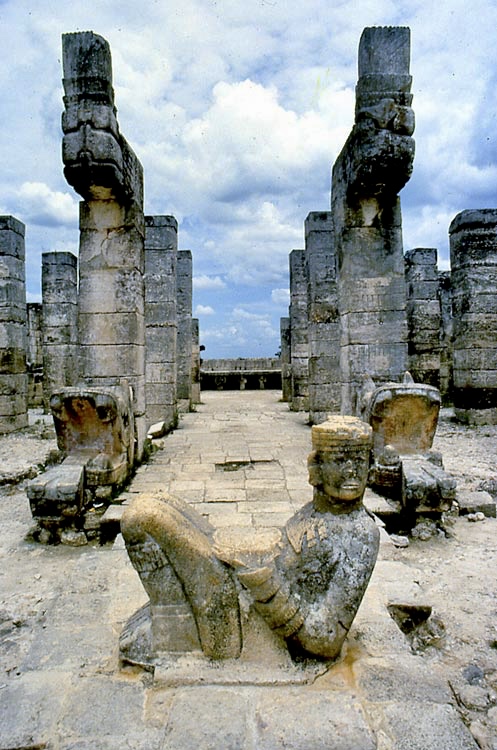
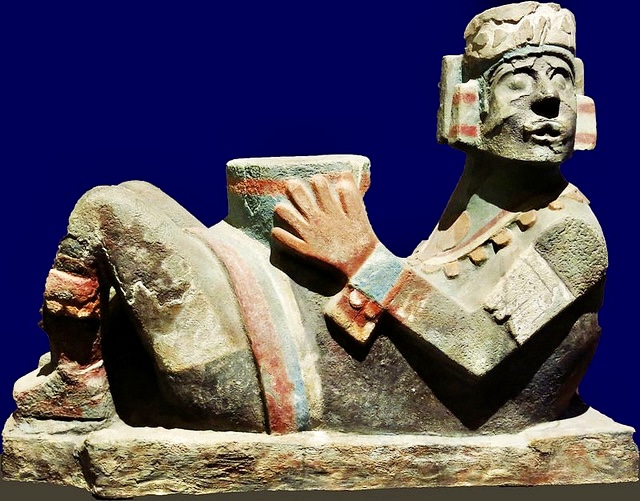
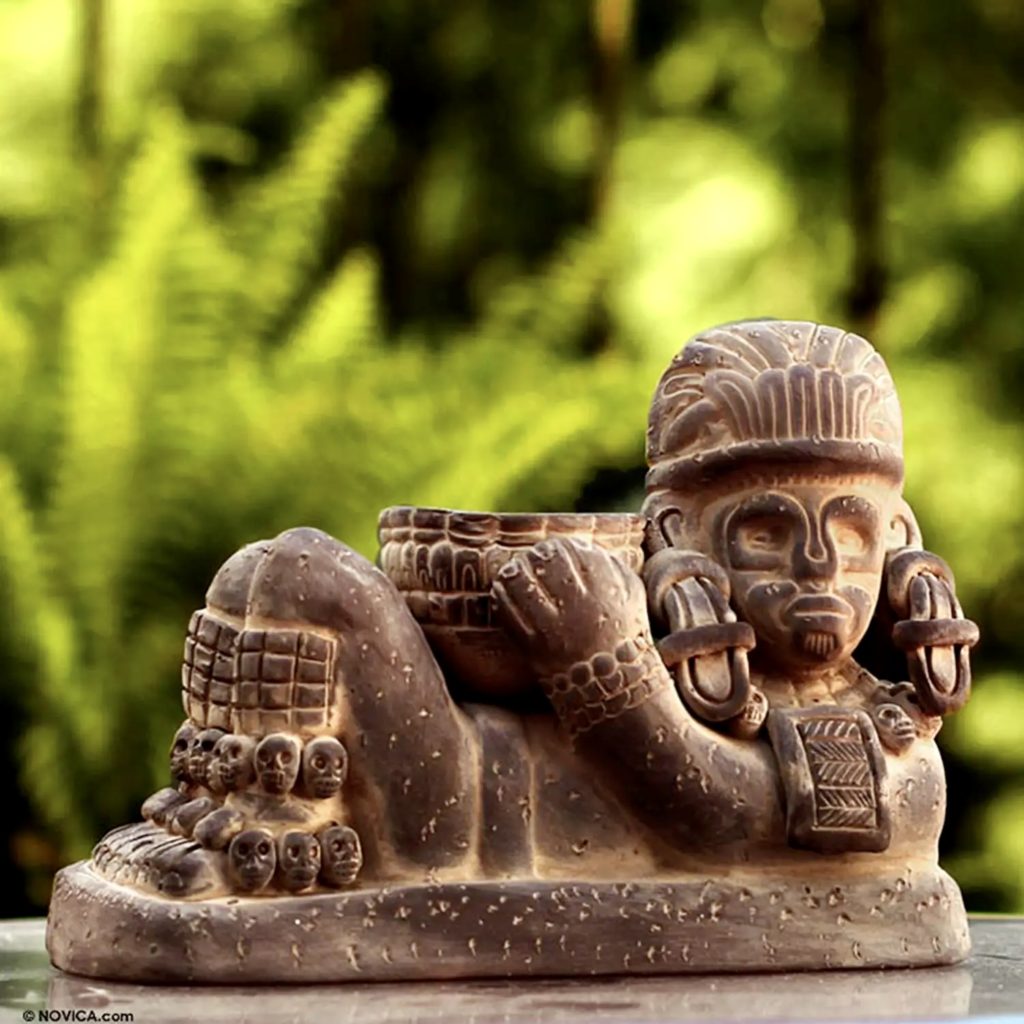

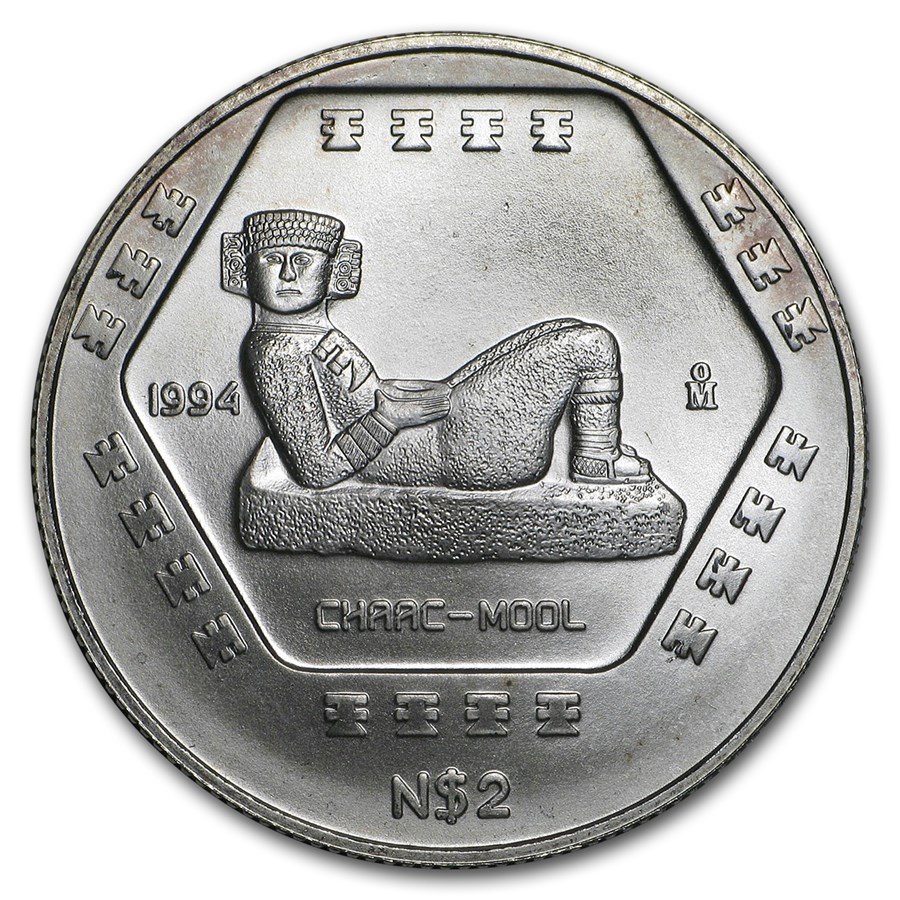
Vintage Carlos Fuentes.
There is a hand sized Chac Mool made of clay on my book shelf.
I guess I’d better go and put some catchup on his stomach.
My own take on the Chac Mool is that after a sacrifice, the heart were placed on the receptacle in his stomach and cooked. The gods did not like their food raw. Then the Chac Mool, who was a messenger of the gods, would rise up to the sky carrying the food to Tlaloc, Quetzalcoatl, Tonantzin, or whoever was getting fed.
Supa!!!¡!!!